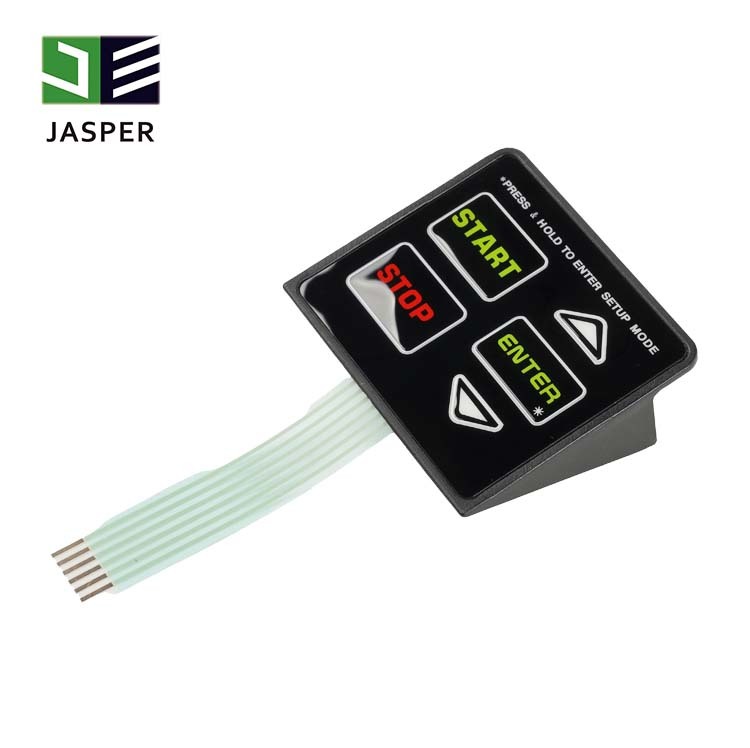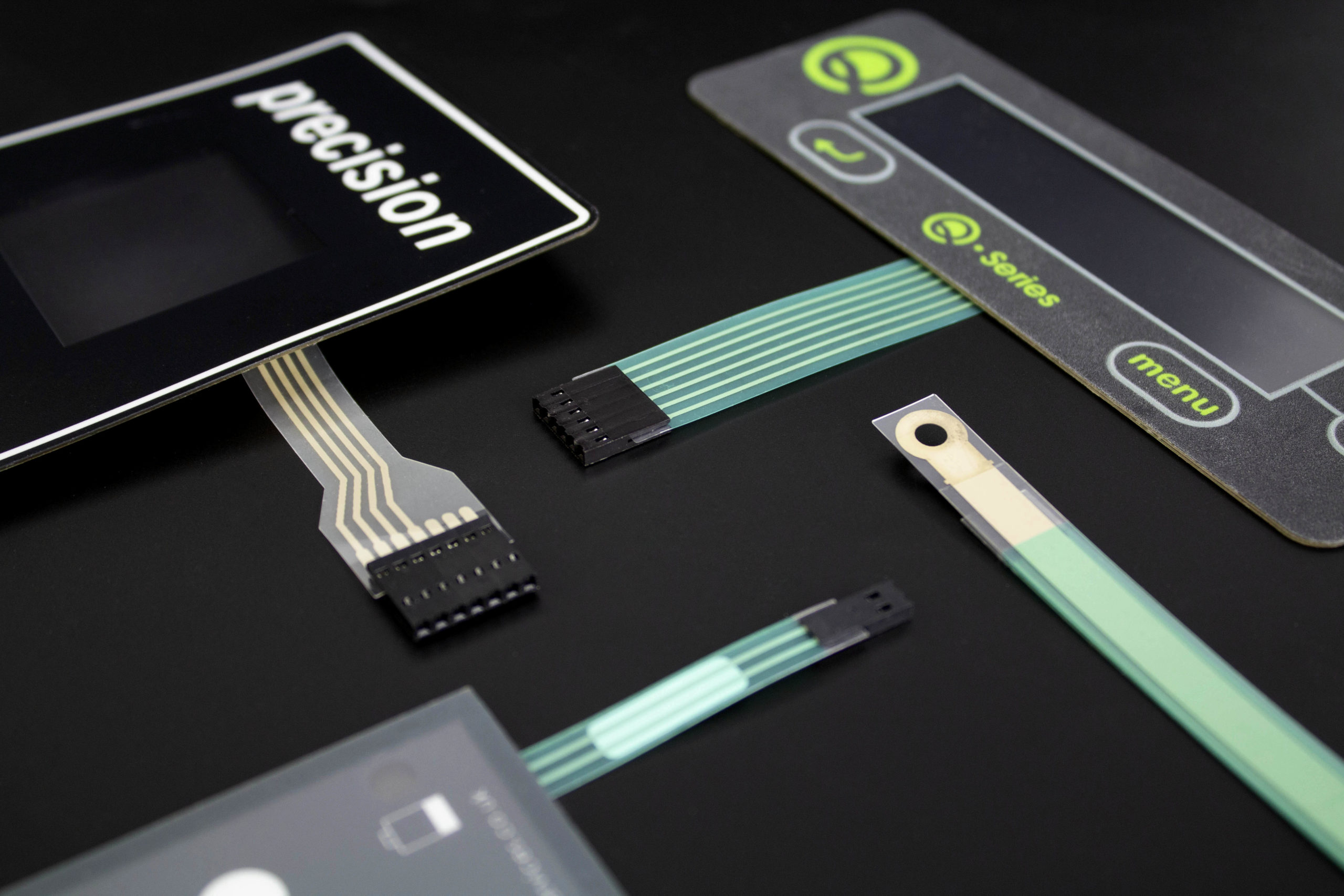All Concerning Membrane layer Switch: A Comprehensive Overview for Beginners
Membrane layer buttons are important components in modern-day electronic devices, using an one-of-a-kind user interface for individual interaction - membrane switch. Their layered building and construction, including overlays and conductive traces, provides functionality and resilience. Unlike typical mechanical switches, membrane layer buttons provide a streamlined layout and personalized alternatives. Comprehending their essential features and advantages can transform product design. The ins and outs of their application and layout factors to consider require further exploration.
What Is a Membrane layer Change?
A membrane switch is a sort of electrical switch that consists of a flexible membrane layer layered over a published circuit board. This design enables a smooth and portable interface, commonly made use of in different digital devices. Membrane layer switches are frequently located in consumer appliances, medical tools, and industrial equipment due to their durability and resistance to environmental factors.The building typically consists of multiple layers, such as graphic overlays and adhesive support, which provide tactile responses and secure the circuitry beneath. The procedure of a membrane layer switch is initiated when pressure is related to the surface, finishing an electrical circuit.These buttons are valued for their adaptability, making it possible for custom styles and published graphics that satisfy details customer interfaces. Their low-profile nature reduces room demands, making them optimal for applications where standard buttons may not fit. On the whole, membrane layer buttons offer a visual and useful option for contemporary digital tools.
Secret Elements of Membrane Changes
Membrane switches comprise several crucial elements that add to their performance and performance. The top layer, called the overlay, gives the interface and is commonly published with graphics or symbols. Under the overlay lies a spacer layer, which divides the conductive elements and protects against inadvertent activation. The following important component is the visuals layer, which improves aesthetic appeals and assures the durability of the design.Conductive traces, commonly made from materials like silver or carbon, are printed on the circuit layer. When pressure is related to the overlay, these traces enter contact, completing the circuit. Additionally, a backing layer supplies structural assistance and can be made from products such as polyester or polycarbonate. With each other, these parts develop a trusted, user-friendly interface appropriate for various applications, from household devices to industrial devices. Recognizing these elements is important for any person thinking about membrane layer switch innovation.
Exactly How Membrane Layer Switches Job
Understanding how membrane layer switches over feature is essential for appreciating their prevalent usage in numerous devices. A membrane layer button runs with a collection of layers, including a graphic overlay, spacer, and a circuit layer. When stress is applied to the overlay, it presses the spacer layer, enabling the circuit layer to make contact and complete an electric circuit. This activity sends a signal to the device, triggering a response, such as activating a light or triggering a function.Membrane switches can be developed with various features, consisting of responsive comments, backlighting, and personalized graphics, boosting individual communication. Their building and construction enables a closed layout, protecting the internal parts from dust, wetness, and impurities. This sturdiness makes them suitable for diverse applications, from consumer electronics to industrial tools. Overall, the simplicity and effectiveness of membrane layer switches over add to their appeal in modern technology.
Advantages of Membrane Layer Switches Mechanical Buttons
While mechanical switches have actually long been a staple in several devices, membrane switches offer distinctive benefits that make them significantly appealing. One significant benefit is their slim profile, enabling more compact layouts and higher flexibility in product advancement. Furthermore, membrane changes function an uniform surface area, which enhances aesthetic appeal and simplifies cleaning, making them appropriate for environments where health is critical.Another advantage is their resistance to dirt and moisture. Unlike mechanical switches, which can be compromised by ecological elements, membrane layer switches provide a sealed interface that shields against contaminants - membrane switch. Membrane switches usually have a longer life expectancy due to fewer moving parts, resulting in improved sturdiness and reliability.Cost-effectiveness is likewise a notable benefit, as membrane switches can be created in bulk with lower production prices. These factors integrate to position membrane switches as a sensible alternative to standard mechanical alternatives in various applications
Usual Applications of Membrane Switches
Membrane layer buttons are widely used in different sectors, particularly in consumer electronics and commercial control board. In consumer gadgets, they offer a streamlined, easy to use user interface, while in industrial settings, they boost sturdiness and capability. Full Article Recognizing these applications highlights the convenience and usefulness of membrane layer buttons in modern technology.
Consumer Electronics Instruments
As consumer electronic devices remain to develop, membrane layer buttons have actually come to be a popular selection for a selection of devices because of their adaptability and sleek style. These switches are commonly discovered in mobile phones, tablet computers, and remote controls, where room is restricted and looks matter. Their low profile and customizable styles allow manufacturers to develop straightforward interfaces that boost the total individual experience. In addition, membrane layer buttons are usually made use of in appliances such as microwaves and coffee machine, supplying user-friendly control options while standing up to moisture and dust. The resilience and dependability of membrane layer changes make them appropriate for everyday consumer items, guaranteeing longevity and constant efficiency. In general, their combination in consumer electronics mirrors a mix of functionality and modern style.
Industrial Control Panels
The applications of membrane switches prolong beyond customer electronics, finding considerable use in i thought about this commercial control board. These buttons are preferred for their resilience and resistance to severe environments, making them suitable for making and procedure control setups. They give a dependable interface for operators to control equipment, screen processes, and readjust setups. Membrane layer switches can be personalized to fit particular operational requirements, incorporating attributes like backlighting and tactile comments, enhancing individual experience. Their inconspicuous style enables for assimilation into various devices, while their capability to hold up against spills, dirt, and extreme temperatures warranties longevity. Generally, membrane layer buttons add to efficient and risk-free operation in commercial applications, showing their adaptability and efficiency sought after atmospheres.
Considerations for Creating Membrane Layer Changes
When creating membrane layer buttons, choosing the appropriate products is important to assure durability and capability. In addition, comprehending layer arrangement methods can greatly impact the button's efficiency and customer experience. These considerations play a vital role in developing reliable and reputable membrane button styles.
Product Option Importance
Material selection plays an essential function in the layout and functionality of membrane layer buttons. The chosen products straight influence the button's toughness, tactile reaction, and total aesthetic. Secret considerations include the substratum, which should offer architectural honesty while enabling adaptability, and the visuals overlay, which requires to be immune to put on and ecological variables. Conductive products must guarantee reputable electric efficiency, while adhesives should provide strong bonding without jeopardizing the switch's procedure. Additionally, compatibility additional reading with producing processes and end-user settings is crucial; materials must withstand varying temperatures, humidity levels, and chemical direct exposure. Inevitably, appropriate material choice not only improves the membrane switch's performance but likewise adds to its durability and customer complete satisfaction, making it a crucial aspect of the layout procedure.

Layer Arrangement Techniques

Often Asked Inquiries
For How Long Do Membrane Layer Switches Usually Last?
Membrane buttons usually have a lifespan of 1 to 5 million cycles, relying on usage and ecological problems. Elements such as design quality and operating regularity significantly influence their resilience and general efficiency long life.

Can Membrane Changes Be Custom-made for Certain Styles?
Membrane layer switches can without a doubt be personalized to accommodate certain designs, permitting diverse shapes, colors, and capabilities. This flexibility allows manufacturers to customize these buttons to meet special aesthetic and functional needs efficiently.
What Products Are Utilized in Membrane Switch Building And Construction?
Membrane buttons are usually created making use of products such as polyester, polycarbonate, and glue layers. These products offer adaptability, toughness, and resistance to environmental aspects, making certain the buttons operate successfully in numerous applications and conditions.
Are Membrane Switches Over Resistant or water resistant to Dampness?
Membrane buttons can be created to be moisture-resistant, using specialized materials and finishings. Their waterproof capacities depend on building and construction quality and specific applications, making it crucial to assess needs for ideal performance in numerous settings.
Exactly How Are Membrane Layer Changes Repaired if Harmed?
Fixing damaged membrane switches over usually includes changing the affected layer or circuit. Professionals may likewise use conductive adhesive or make use of specialized fixing kits, making certain capability is restored without complete replacement of the whole button setting up. Unlike standard mechanical switches, membrane layer buttons present a sleek design and customizable choices. A membrane switch is a type of electrical button that consists of a versatile membrane layered over a printed circuit board. The operation of a membrane layer switch is initiated when stress is applied to the surface area, finishing an electric circuit.These switches are valued for their convenience, allowing custom designs and published graphics that cater to particular user interfaces. While mechanical switches have actually long been a staple in numerous tools, membrane changes deal distinct advantages that make them significantly appealing. Membrane switches generally have a longer lifespan due to fewer relocating components, resulting in enhanced toughness and reliability.Cost-effectiveness is additionally a remarkable advantage, as membrane layer buttons can be produced in bulk with lower manufacturing expenses.